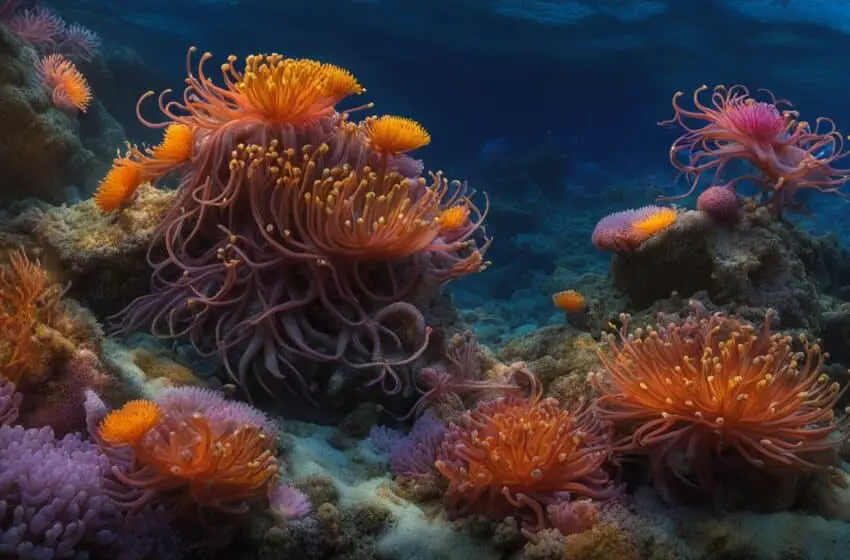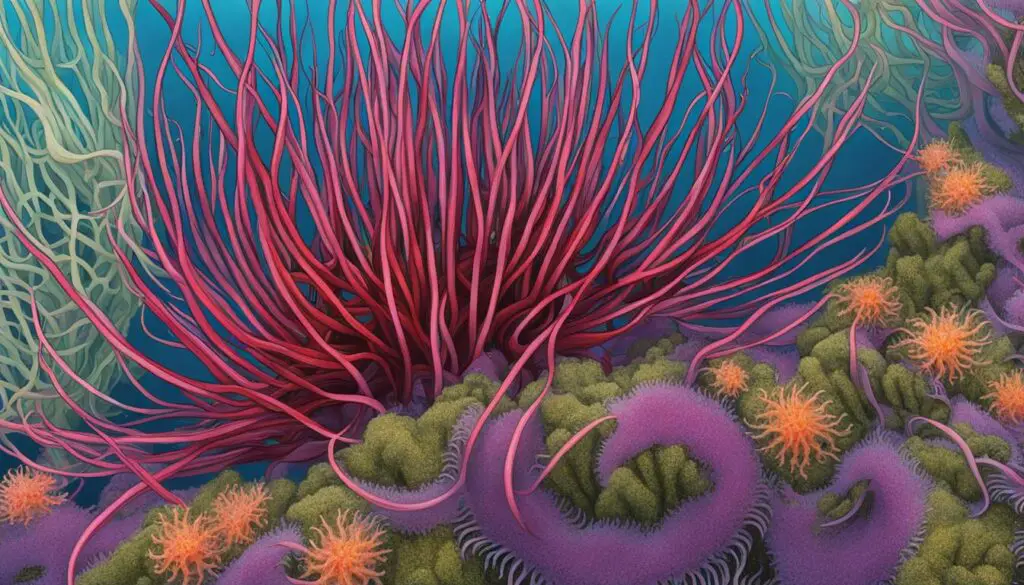Unveiling The Secrets: Sea Anemones’ Lifecycle And Adaptations

Sea anemones, with their vibrant colors and graceful movements, have long fascinated scientists and nature enthusiasts alike. But have you ever wondered about the intricate details of their life cycle? From their development to reproduction, stages of growth to metamorphosis, sea anemones hold many secrets waiting to be uncovered.
Sea anemones, Non-native species have shown extraordinary flexibility, thriving in varied ecosystems and establishing themselves in new places. Their adaptability and human influence have helped them colonize new regions. Ten globally introduced sea anemone species have unique life histories that help them survive and spread.
Key Takeaways
- The life cycle of sea anemones encompasses various stages, from development to reproduction.
- Sea anemones demonstrate phenotypic plasticity, allowing them to adapt to changing environments.
- Anthropogenic activities have facilitated the introduction and colonization of sea anemones in new regions.
- Unique life history strategies enable sea anemones to thrive and establish in diverse habitats.
- Understanding sea anemone life cycles provides insights into their adaptation and potential implications for future introductions.
Diet and Feeding Habits of Sea Anemones
Sea anemones, with their bright colors and delicate tentacles, have a varied food and feeding behaviors. They hunt and devour many small animals, demonstrating their versatility and survival skills. The enormous plumose anemone, the tallest sea anemone on Earth, has amazed experts with its feeding habits.
Researchers used DNA barcoding to determine what giant plumose anemones eat. The anemones consume insects and other oddities. A study found that huge plumose anemone guts contained a lot of Lasius pallitarsis bug DNA. Sea anemones may feed terrestrial insects blown into the ocean during nuptial flights.
The findings suggest intricate marine-terrestrial interactions. We can understand sea anemones’ eating habits and nature’s complex relationships by knowing they devour insects. This study advances sea anemone biology and supports feeding pattern research.
| Sea Anemone Diet | Prey | Feeding Habits |
|---|---|---|
| Giant Plumose Anemones | Copepods, Barnacles, Crab larvae, Insects | Can prey on terrestrial insects blown into the water during nuptial flights |
Knowing how sea anemones, especially the big plumose, eat helps us understand marine ecosystems and their complex dynamics. Unlocking the mysteries of these fascinating organisms helps scientists understand the natural world and expand their research.
Limb Growth in Sea Anemones: Genetic and Environmental Factors
Starlet sea anemones (Nematostella vectensis) can grow tentacle arms. Recent research demonstrates genetic and environmental factors affect limb growth. Contrary to theories that genetics dictate limb growth, nutrition affects sea anemone lifespan and tentacle arm count. This contradicts our understanding of genetic regulation in limb development and suggests that environmental factors affect sea anemone growth.
Extra nutrients also turn muscle cells into tentacles, the study showed. Sea anemones may remodel and adapt to their environment due to their remarkable flexibility. Environment and food availability help sea anemones grow limbs. Genomic and environmental interactions allow sea anemones to flourish in diverse settings and adapt to environmental changes due to their phenotypic plasticity.
The genetic tractability and unique regenerative properties of the starlet sea anemone make it a model organism for studying limb growth and regeneration. Explore sea anemones’ genetic mechanisms of environmental impacts and limb growth to learn about developmental biology and similar processes in other animals. The complicated link between genetics and the environment in sea anemone limb growth illuminates other species’ phenotypic alterations and adaptations.

Environmental Factors Influencing Limb Growth
Environmental factors play a significant role in sea anemone limb growth. Along with food availability, factors such as temperature, light, water quality, and symbiotic relationships can influence the rate and extent of limb development. Studies have shown that variations in these environmental parameters can lead to alterations in the growth patterns of sea anemones, suggesting that they actively respond to their surroundings to optimize their limb growth.
Genetic Control vs. Environmental Influence
The discovery of the significant impact of environmental factors on sea anemone limb growth challenges the long-held belief that genetics solely dictate developmental processes. While genetic control undoubtedly plays a role in determining the potential for limb growth, the environment serves as a critical modulator, enhancing or inhibiting limb development based on available resources. Understanding the delicate balance between genetic instructions and environmental cues can pave the way for a comprehensive understanding of developmental processes across various organisms.
| Environmental Factors | Influence on Limb Growth |
|---|---|
| Food availability | Crucial determinant of the number of tentacle arms grown |
| Temperature | Can influence the rate and extent of limb development |
| Light | May impact the growth patterns of sea anemones |
| Water quality | Can affect the overall health and growth of sea anemones |
| Symbiotic relationships | Interactions with symbiotic organisms can influence limb development |
Conclusion
The life cycle of sea anemones is a fascinating subject that highlights the intricate interplay between genetic and environmental factors. These remarkable creatures demonstrate remarkable adaptations, allowing them to thrive in various habitats and overcome challenges posed by changing climates and human activities.
From their diet and feeding habits to their limb growth patterns, sea anemones challenge our traditional understanding of genetic control in body development. Their ability to capture and consume a diverse range of prey, including terrestrial insects blown into the water, showcases their unique ecological role.
Furthermore, the discovery that sea anemone limb growth is influenced by the amount of food consumed throughout their lifetime emphasizes the significant role of environmental factors in shaping their morphology. This finding challenges long-standing notions of genetics as the sole determinant of limb development.
The research on sea anemones holds implications for the field of developmental biology as it raises new questions about the complex interplay between genetics and environment in shaping an organism’s physiology and morphology over time. Further studies on sea anemone feeding ecology and limb growth mechanisms will undoubtedly contribute valuable insights to our understanding of developmental processes in other organisms.
FAQ
What are the most common non-native sea anemone species?
Ten globally introduced sea anemone species have been identified.
What do sea anemones feed on?
Sea anemones capture and consume a variety of small prey, including copepods, barnacles, crab larvae, and insects.
What is the unique feeding behavior of giant plumose anemones?
Giant plumose anemones have been observed feeding on a diverse range of organisms, including ants.
How do sea anemones grow and regenerate their tentacle arms?
Sea anemones, such as the starlet sea anemone, have the ability to grow and regenerate their tentacle arms. The number of arms an individual can grow is determined by the amount of food it consumes throughout its lifetime.
What influences the life cycle and development of sea anemones?
The life cycle and development of sea anemones are influenced by a combination of genetic and environmental factors.



